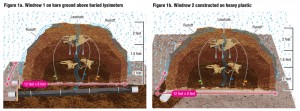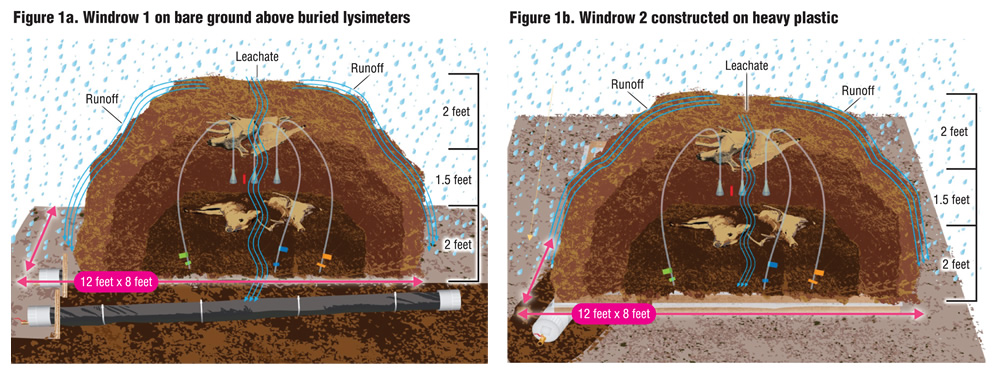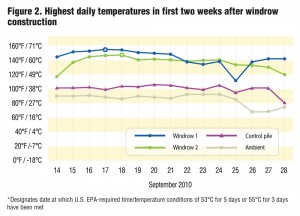Study investigating static windrow composting of road-killed deer with wood chips finds minimal leachate discharge and effective pathogen destruction.
B.M. Donaldson, G. P. Smith, Y. Kweon, D.L. Wilson and N. Sriranganathan
BioCycle October 2012, Vol. 53, No. 10, p. 39
Approximately 1.1 million deer-vehicle collisions occur in the United States each year. Many states are trying to identify cost-effective and environmentally friendly ways to manage the millions of animal carcasses left on the roadside. Currently, the predominant methods include using disposal facilities, such as landfills, and burying or dragging the carcasses further from the road within the right of way. These disposal methods have several costly and unsustainable disadvantages, including long travel distances to landfills, increasing landfill restrictions, and lack of viable burial areas. Composting is one easily managed option that has met with success in some states, while other states have costly regulations that unintentionally discourage implementation.

Figure 1a. Windrow 1 on bare ground above buried lysimeters | Figure 1b. Windrow 2 constructed on heavy plastic
In Virginia, more than 48,700 deer-vehicle collisions occurred from 2010 through 2011. The Virginia Department of Transportation (VDOT) is responsible for the removal and disposal of carcasses along the state road system and has spent an annual average of $4.1 million on carcass removal and disposal in the past five fiscal years (2007-2011). A study conducted by the Virginia Center for Transportation Innovation and Research (VCTIR), VDOT’s research division, constructed passively aerated static composting windrows containing deer carcasses and monitored them over the course of a 1-year study period. The windrows were analyzed for pathogen destruction and the degree to which underlying soil filtered leachate contaminants.
Study Design
The construction of the windrows involved enveloping the carcasses of road-killed deer in wood chips and allowing the windrows to sit undisturbed. Figures 1a and 1b illustrate the windrow designs used in this study. The wood chips were obtained from VDOT chipping machines and are readily available to most maintenance areas in the state. The absorbent and bulky quality of wood chips helps maintain proper moisture levels and oxygen flow, and their high carbon content balances the high nitrogen content of animal carcasses.
Three 8-foot by 12-foot static composting windrows were constructed and monitored for one year. Windrow 1 (Figure 1a) contained four deer carcasses and was constructed on bare ground above two buried lysimeters. The lysimeters collected leachate that percolated through the windrow and 10 inches of underlying soil. Windrow 2 (Figure 1b) also contained four deer carcasses and was designed to demonstrate a worst case scenario with no filtering of leachate through the soil beneath the windrow. This windrow was constructed on heavy plastic that prevented leachate from entering the soil. Windrow 3 was constructed with the same design used with Windrow 1, but Windrow 3 contained only wood chips and served as the control for the study. Leachate volume was measured after each rainfall over the course of one year. Leachate was analyzed for constituents present in animal mortality (total organic carbon, chloride, ammonia-nitrogen, and nitrate-
nitrogen). The compost temperature was continuously monitored with the use of data loggers placed in the center of each windrow.
To study destruction of common indicator pathogens, it was necessary to ensure their presence in the windrows. Suspensions of three pathogens (eggs of a parasitic worm [helminth], the bacterial pathogen Salmonella, and the bacterial pathogen E. coli) were contained in flasks fit with tubing. The tubing was used to draw flask samples from outside the windrows without disturbing the windrows. The flasks were placed in all three windrows and sampled regularly over the course of the study.
Findings
The maximum temperature (69°C/156°F) attained in both experimental windrows was reached by Day 4. By Day 5, both experimental windrows met the EPA Part 503 time and temperature pathogen destruction composting requirements of maintaining 55°C for 3 days (Figure 2). In response to these high windrow temperatures, indicator pathogens (in samples collected from the flasks) were destroyed in less than three months. E. coli and Salmonella in flasks in both experimental windrows were reduced by 99.99% by Day 7 and reached zero growth by the second sampling date, Day 14 of the study. Intact helminth eggs in both experimental flasks were significantly reduced by the first sampling date and were deemed nonviable by Day 77.
Contaminants in leachate were also compared to those in livestock mortality composting. Composting livestock mortalities on farms is a common practice in the United States and worldwide. Some state regulations allow the natural soil filtration of leachate from animal mortality windrows constructed onsite at the farm of generation but require that leachate from composting windrows containing deer and other mortality collected from roadways be captured and prevented from infiltrating soil. The highest contaminant concentrations from deer windrows constructed from woodchips were nine times lower than those reported from research of cow windrows constructed from cover material common to farms.
These findings can be used by states to support regulatory negotiations to reduce composting requirements for road-killed deer composting and increase implementation prospects. VDOT is sharing these findings with the state environmental regulatory agency with a goal of incorporating this practice into regular operations.
VCTIR is currently conducting a study of composting vessels, such as rotary drums and forced aeration containers, as another means of roadkill composting. Following completion of this study and the investigation of compost end use options, VCTIR will work with VDOT to create guidelines and video training for windrow and vessel methods of animal mortality composting. This will provide VDOT maintenance areas with more options for carcass management.
Bridget Donaldson is a Senior Research Scientist with the Virginia Department of Transportation’s (VDOT) Virginia Center for Transportation Innovation and Research (VCTIR). Garrett Smith is a Graduate Student in the Department of Biomedical Sciences and Pathobiology Virginia-Maryland Regional College of Veterinary Medicine (V-MRCVM) at Virginia Tech. Young-Jun Kweon is a Research Scientist with VCTIR. Nammalwar Sriranganathan is a Professor in Virginia Tech’s Department of Biomedical Sciences and Pathobiology, V-MRCVM. David Wilson is Hazardous Materials Compliance Manager with VDOT. The full report can be downloaded at http://vtrc.virginiadot.org.











